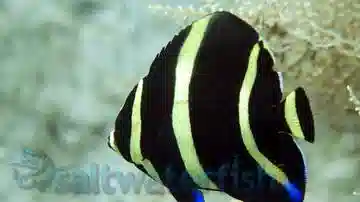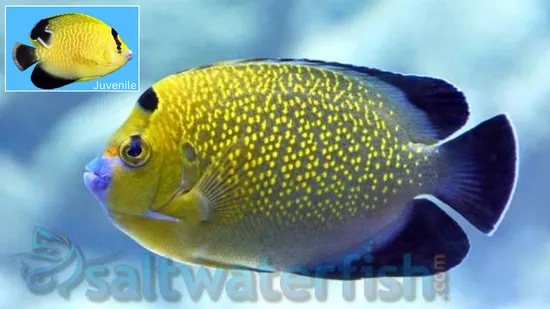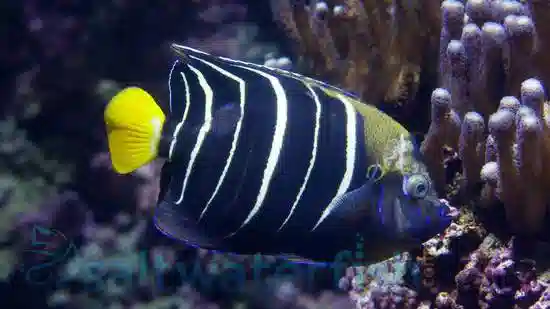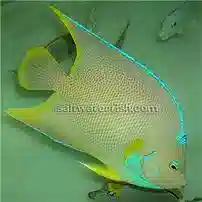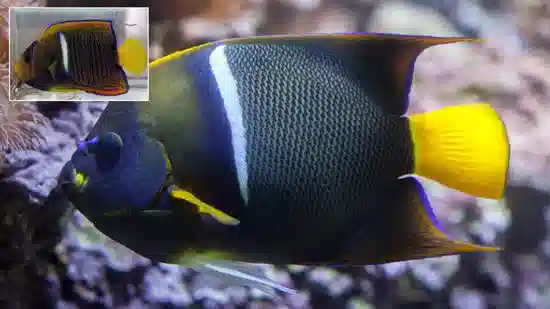Passer Angelfish
Holacanthus passer
(1 Reviews)
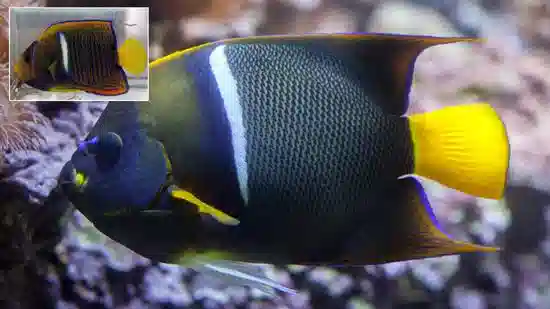
Passer Angelfish
Holacanthus passer
(1 Reviews)
{{ item.name }}
Size: {{ item.extra_field_3 }}
${{ getFormattedPrice(item.saleprice) }} ${{ getFormattedPrice(item.price) }}
To join the waiting list, click here
Free Shipping
With
$199.00
or more in Marine Life.
More details...
Passer Angelfish Care Facts
| Care Level: | Moderate |
|---|---|
| Temperament: | Semi-Aggressive |
| Diet: | Omnivore |
| Reef Safe: | No |
| Minimum Tank Size: | 120 gallons |
| Max Size: | 14 inches |
Keeping the Passer Angelfish (Holacanthus passer) in Your Saltwater Aquarium
The Passer Angelfish, scientifically known as Holacanthus passer, is a captivating marine species that adds elegance and charm to any saltwater aquarium. This comprehensive guide will provide essential information for those considering the Passer Angelfish as an addition to their aquatic community. We will cover various aspects, including habitat, reef compatibility, size, lifespan, dietary needs in captivity, availability through aquaculture, compatibility with other marine species, sexual dimorphism, juvenile to adult coloration changes, temperament, detailed tank requirements, and precise water conditions. Additionally, we will list common names for this species and highlight practical reasons for choosing the Passer Angelfish from Saltwaterfish.com.
Habitat and Natural Range of the Passer Angelfish
The Passer Angelfish is native to the tropical waters of the Western Atlantic Ocean, primarily found in the Caribbean Sea and the Gulf of Mexico. In its natural habitat, it inhabits coral reefs, rocky crevices, and areas with abundant coral growth. To ensure the well-being of your Passer Angelfish in captivity, it's crucial to replicate these conditions within the aquarium.
Reef Compatibility of the Passer Angelfish
The Passer Angelfish is not considered reef-safe. This species is known to nip at coral polyps and sessile invertebrates, making them unsuitable for a traditional coral reef setup. However, they can thrive in a fish-only or fish-only-with-live-rock (FOWLR) system. When keeping them in a reef aquarium, please exercise caution and closely monitor their behavior to prevent damage to corals.
Size and Lifespan of the Passer Angelfish
Passer Angelfish can grow to approximately 10 to 14 inches (25 to 35 centimeters) in captivity, making them a substantial addition to your aquarium. They can live for 10 to 15 years or even longer with proper care and a suitable environment.
Diet in Captivity of the Passer Angelfish
Feeding the Passer Angelfish in captivity requires a varied diet to ensure their health and vitality. Include the following foods in their diet:
- High-Quality Marine Pellets: Incorporate high-quality marine pellets into their daily feeding routine to provide essential nutrients.
- Frozen and Fresh Foods: Supplement their diet with various frozen and fresh offerings, such as brine shrimp, mysis shrimp, and enriched frozen preparations.
- Vegetable Matter: Passer Angelfish are omnivorous and benefit from including marine algae and plant matter in their diet. Offer seaweed sheets or clips to meet this dietary requirement.
Aquaculture and Availability of the Passer Angelfish
While Passer Angelfish are occasionally available through aquaculture, a significant portion of them in the aquarium trade are still wild-caught. When sourcing these fish, choosing reputable suppliers like Saltwaterfish.com is essential to ensure the health and well-being of your new addition.
Compatibility with Other Fish and Invertebrates
Passer Angelfish can be territorial and occasionally aggressive toward other fish, particularly other angelfish. However, they can coexist with suitable tankmates in a spacious aquarium. Here are five compatible species to consider:
- Yellow Tang (Zebrasoma flavescens): These active herbivores can thrive alongside Passer Angelfish.
- Royal Gramma (Gramma loreto): These peaceful fish are an excellent choice for a Passer Angelfish community tank.
- Clownfish (Amphiprion spp.): Known for their symbiotic relationships with anemones, clownfish are suitable tankmates.
- Blue Tang (Paracanthurus hepatus): Blue tangs can be eye-catching companions with their striking blue and yellow coloration.
- Damsels (Chromis spp.): Many damsel species are small and peaceful, making them compatible tank mates.
Sexual Dimorphism of the Passer Angelfish
Passer Angelfish do not exhibit significant sexual dimorphism, making it challenging to distinguish between males and females visually.
Juvenile to Adult Coloration Changes
Juvenile Passer Angelfish showcases a bold and vibrant coloration, characterized by striking yellow and blue stripes extending across their body. As they mature into adults, their coloration becomes more subdued, transitioning to a deep blue-black hue with a yellow tail.
Tank Requirements for the Passer Angelfish
To provide an ideal environment for your Passer Angelfish, adhere to these tank requirements:
- Minimum Aquarium Size: A tank with a capacity of at least 120 gallons (500 liters) is recommended for a single Passer Angelfish. A larger tank is essential to accommodate their substantial size and swimming needs.
- Decor and Hiding Places: Incorporate ample live rock structures, caves, and hiding spots to provide security and refuge for your angelfish.
- Water Conditions: Maintain stable water conditions with the following parameters:
- pH: 8.1 to 8.4
- Salinity: 1.020 to 1.025
- Water Temperature: 74 to 80°F (23 to 27°C)
- Water Flow: Moderate to strong water flow is suitable for Passer Angelfish.
List of Common Names for the Passer Angelfish
Various common names, including King Angelfish, and Blue Angelfish, are known as Passer Angelfish.
Why People Should Buy the Passer Angelfish from Saltwaterfish.com
Choosing Saltwaterfish.com as your source for the Passer Angelfish offers several practical advantages:
- Quality Assurance: Saltwaterfish.com is committed to providing top-quality marine life. Each Passer Angelfish is meticulously selected and cared for to ensure its well-being.
- Expert Guidance: Saltwaterfish.com offers valuable resources and expert advice to help you create and maintain an ideal aquarium environment for your Passer Angelfish.
- Convenience: With an easy-to-navigate online platform, Saltwaterfish.com offers a secure and convenient way to purchase marine fish and essential aquarium supplies.
- Sustainability: Opting for Saltwaterfish.com supports responsible sourcing practices, contributing to conservation efforts and preserving marine ecosystems.
In conclusion, the Passer Angelfish (Holacanthus passer) is a stunning addition to any saltwater aquarium. While their care demands attention to detail, the reward of having this beautiful species in your tank is well worth the effort. Ensure the health and well-being of your Passer Angelfish by sourcing them from reputable suppliers like Saltwaterfish.com.
Love this Passer Angelfish! He is so beautiful and such an interesting personality! He doesn't bother anyone and has actually become friends with our yellow wrasse! They swim attached at the hip looking for food! He is a very mellow swimmer who loves swimming through the rock work to find new caves. He is a little hard to feed when competing with quicker eaters, I let a couple pellets sink in front of him and sink a few spirulina flakes)! I highly recommend him, he is sweet, beautiful, and easy!
Reviewed by: Shia M. on Sept. 11, 2021


